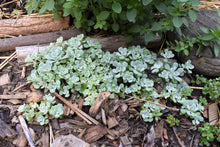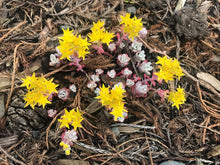
Sedum spathulifolium
Broadleaf stonecrop, like its cousin Oregon stonecrop, is a highly ornamental, evergreen groundcover. Its succulent leaves vary widely in color and form but are generally compact rosettes with a powdery bluish hue that transitions to reddish-purple as the plant ages. In mid-spring, prolific clusters of bright yellow flowers burst into bloom atop short, upright stems and are favored by native pollinators and beneficial insects.
- Plant type/canopy layer: evergreen, perennial, herbaceous plant
- Size at maturity: 3-6" tall, spreads laterally by rhizomes, creating a groundcover
- Light requirements: full to mostly sunny
- Moisture requirements: moist to dry soil
- Bloom time: April to August (May - June in the Portland Metro area)
- Growth rate/ease: medium growth rate, easy to grow
- Wildlife support: flowers attract and provide nectar to adult butterflies, bees and other insect pollinators; overall plant attracts and supports beneficial and pest eating insects and is a caterpillar host plant and larval food source for native butterflies and moths
- Native habitat/range: locally common in rocky outcrops and ledges, gravelly places, and slopes, from sea level to 1500m, across the Pacific Northwest from the coast to the Cascades. Portland Plant List - yes.
- Special features & uses: evergreen; groundcover; landscape uses include pollinator gardens, greenroofs, rock gardens, rock walls and potted arrangements
Gardening with Broadleaf Stonecrop: This is an excellent choice for sunny pollinator gardens, containers, and rocky borders with moist to dry, well-drained soil. It’s slightly harder to establish, but the striking, unique color is worth accepting a little mortality. If you hope to achieve this consistent groundcover effect, a good strategy is to buy many, expecting that some will not make it, and space them every 6”-12” apart.
Photo Credit 1, 3-6: Nikkie West, Sparrowhawk Native Plants
Photo Credit 2: "Pacific Sedum (Sedum spathulifolium)" by StephanieFalzone is licensed under CC BY 2.0
Photo Credit 7: Hoddick Photography













